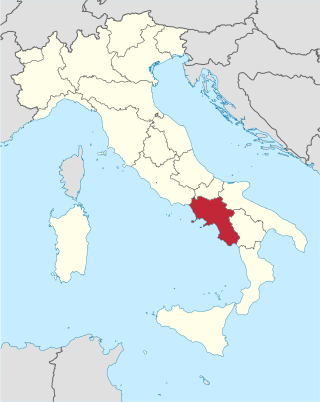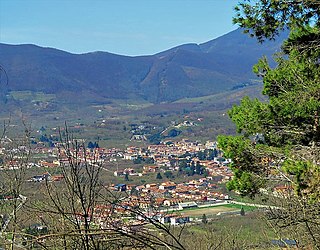
Campania is an administrative region of Italy located in Southern Italy; most of it is in the south-western portion of the Italian Peninsula, but it also includes the small Phlegraean Islands and the island of Capri. The capital of the Campania region is Naples. As of 2018, the region had a population of around 5,820,000 people, making it Italy's third most populous region, and, with an area of 13,590 km2 (5,247 sq mi), its most densely populated region. Based on its GDP, Campania is also the most economically productive region in Southern Italy and the 7th most productive in the whole country. Naples' urban area, which is in Campania, is the eighth most populous in the European Union. The region is home to 10 of the 58 UNESCO sites in Italy, including Pompeii and Herculaneum, the Royal Palace of Caserta, the Amalfi Coast, the Longobardian Church of Santa Sofia in Benevento and the Historic Centre of Naples. In addition, Campania's Mount Vesuvius is part of the UNESCO World Network of Biosphere Reserves. The Region plays also a key international role in international diplomacy, since it is home to NATO's Allied Joint Force Command Naples and of the Parliamentary Assembly of the Mediterranean.

Avellino is a town and comune, capital of the province of Avellino in the Campania region of southern Italy. It is situated in a plain surrounded by mountains 47 kilometres (29 mi) east of Naples and is an important hub on the road from Salerno to Benevento.
San Lupo is the name of a hill town and comune in the province of Benevento, in the Campania region of southern Italy. It is a member of the Titerno "Local Action Group".

Circumvesuviana is a railway network in the east of the Naples metropolitan area, previously run by a company of the same name, now operated by Ente Autonomo Volturno. Electrically powered throughout, the system uses the narrow gauge of 950 mm and operates 142 km (88 mi) of route on six lines. It is entirely separate from other national and regional railway lines. It has 96 stations with an average interstation distance of 1.5 km (0.9 mi).

Forino is a town and comune in the province of Avellino, Campania, southern Italy.

Cerreto Sannita is a comune (municipality) in the Province of Benevento in the Italian region Campania, located about 60 km northeast of Naples and about 25 km northwest of Benevento.

Cusano Mutri is a comune (municipality) in the Province of Benevento in the Italian region Campania, located about 60 km northeast of Naples and about 35 km northwest of Benevento.

San Lorenzello is a comune (municipality) in the Province of Benevento in the Italian region Campania, located northeast of Naples and about 25 kilometres (16 mi) northwest of Benevento.
San Martino may refer to:

The Naples–Salerno high-speed railway line is a link in the Italian high-speed rail network opened in June 2008. The 29-kilometre-long (18 mi) line is one of the new high-speed lines being built to strengthen rail transport system in Italy and in particular freight and passenger transport in Campania. The line is part of Corridor 1 of the European Union's Trans-European high-speed rail network, which connects Berlin and Palermo.

Benevento railway station is the main station serving the city and comune of Benevento, in the region of Campania, southern Italy. Opened in 1868, it forms part of the Naples–Foggia railway, and is also a terminus of three secondary railways, linking Benevento with Campobasso, Avellino, and Cancello, respectively.

Avellino is the main railway station of the Italian city of Avellino, in the region of Campania. It is owned by the Ferrovie dello Stato, the national rail company of Italy, and is classified Silver.

Montoro is an Italian comune (municipality) of the province of Avellino, Campania. The municipal seat is in the town of Piano.
The ecclesiastical region of Campania is one of the sixteen ecclesiastical regions of the Catholic Church in Italy. It consists of three ecclesiastical provinces, twenty-two dioceses, one territorial prelature, and two territorial abbeys. Its territory roughly corresponds with the Italian Republic homonymous region's one.
The following is a timeline of the history of the city of Salerno in the Campania region of Italy.

The strada statale 18 "Tirrena Inferiore" an Italian state highway 406.15 kilometres (252.37 mi) long in Italy located in the regions of Campania, Basilicata and Calabria. It is among the longest and most important state highways in southern Italy, considering that it follows the Tyrrhenian coast, from Salerno to Reggio di Calabria.
The 1688 Sannio earthquake occurred in the late afternoon of June 5 in the province of Benevento of southern Italy. The moment magnitude is estimated at 7.0, with a Mercalli intensity of XI. It severely damaged numerous towns in a vast area, completely destroying Cerreto Sannita and Guardia Sanframondi. The exact number of victims is unknown, although it is estimated to total approximately 10,000. It is among the most destructive earthquakes in the history of Italy.
The Cesina family is an Italian family of Roman-Lombard origin.

Strada statale 7 Via Appia is an Italian state highway 713.45 kilometres (443.32 mi) long in Italy located in the regions of Lazio, Campania, Basilicata and Apulia that follows the path of the ancient Appian Way, connecting Rome to Brindisi. In the stretch between Cisterna di Latina and Terracina, the SS 7 is called "fettuccia di Terracina" due to its straight line. It constitutes a section of the European route E90 from Taranto to Brindisi.













